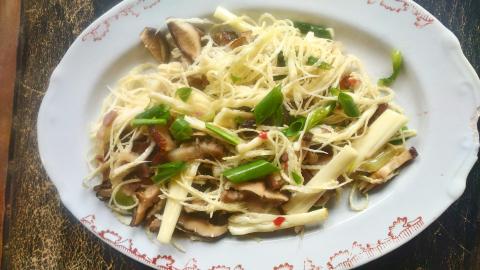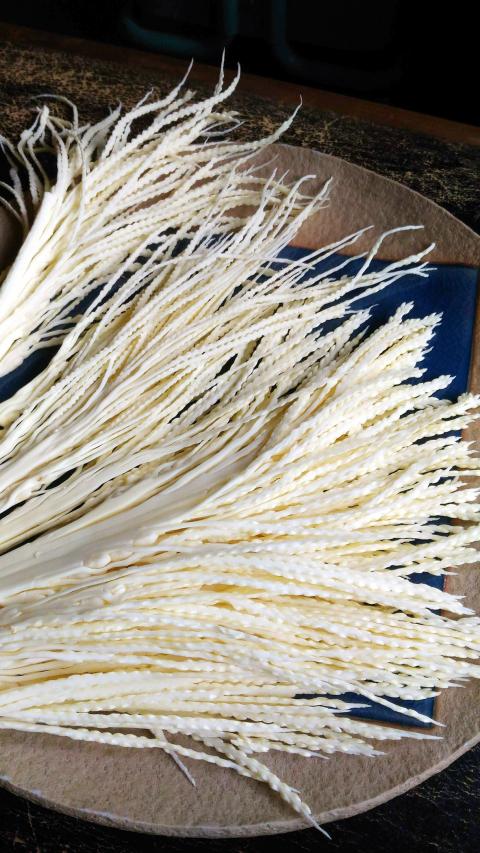Few foods come with as many health caveats as betel nut, the chewing of which remains closely associated with Taiwanese culture despite strenuous government effort to discourage the practice. The betel nut has psychoactive substances that promote its use as a stimulant, and it is sold around Taiwan, most famously by betel nut beauties, scantily clad women who are displayed in glass shop fronts.
HEALTH HAZARD
The beauties have gained Taiwan some international notoriety, but apart from the sexual exploitation inherent in this manner of marketing, the chewing of betel nut is also closely associated with oral and other cancers and its use generally acknowledged as a health hazard.

Photo: Ian Bartholomew
That said, it remains a highly valuable crop and huge areas are dedicated to its cultivation, particularly fragile hillside lands in southern Taiwan, where it is responsible for server environmental degradation. It is widely accepted as a major culprit in a number of devastating mud slides that have destroyed lives and communities. It’s high value means that efforts to curb the planting of betel nut around Taiwan have had limited effect and it is still a major feature of scenery in southern Taiwan.
Overall, there is really not much of an upside to betel nut as a commercial crop. Nevertheless, one culinary curiosity does emerge from this harmful agriculture. This is the betel nut flower (檳榔花), which is sometimes found on the menus of Taiwanese eateries dealing in local specialties and the cuisine of Taiwan’s indigenous peoples.
Despite the notoriety of the betel nut and its close association with Taiwan culture, betel nut flower is not a regular feature in the supermarket vegetable aisle. It has a relatively short season around this month, and is most likely to be found in traditional markets. In restaurants, it is usually served either stir fried or as a cold dish, appreciated for its crunchy texture.

Photo: Ian Bartholomew
The reason that the government seeks to discourage the chewing of betel nut is for the simple fact that this habit can cause cancer, particularly of the mouth. The fact that it remains popular is due to its effects as a powerful stimulant, and despite best efforts, remains popular, particularly among Taiwan’s working class who use it to get thought the physical demands of manual labor or soul-crushingly long hours behind the wheel of long haul trucks.
It is no coincidence that major highway interchanges in southern Taiwan remain a focal point for the betel nut beauties, providing the double whammy of sexual titillation and drug-induced vitality. Cancer, the gradual disintegration of teeth, foul breath, a diseased mouth and throat, can all seem like a high price to pay for a momentary high.
Despite its ill effects, like many expats in Taiwan, I have tested its psychoactive properties as part of the “Taiwan experience.” For myself, a single test was enough to put any notion of establishing solidarity with the Taiwan working class through the participation in the betel nut ritual behind me.
Others have found betel nut to be an interesting and exciting experience, so I will not seek to judge on this issue, but it should be emphasized that regardless of the kind of high you can get from betel nut, the powerful alkaloids it contains will certainly not do you any good in the long run. Betel nut is most often sold with flavoring agents such as slacked lime that (slightly) improve its flavor, but which have terrible effects on oral health and hygiene.
While the flower does not present the carcinogenic dangers of the nut, most sources recommend its consumption only in moderation, as it contains alkaloids such as arecoline, which can lead to sweating and difficulty in breathing. Nausea, vomiting and stomach pain are also associated with excessive consumption of betel nut flower.
NOT ALL DOOM AND GLOOM
It is not all doom and gloom for the betel nut flower, as eaten in moderation it can stimulate digestion and some studies have even shown that arecoline in some forms may be active in retarding the onset of dementia. Betel nut also has a number of uses in ayurvedic medicine.
On the culinary front, the betel nut flower is prized for its crunchy texture and its fresh flavor that can stand out even against strong flavors. As delicious as it is, I am only able to eat it in very small quantities, primarily due to the fact that while the chemical properties of the flower are much slighter than that of the nut, I find that after three or four mouthfuls, I sometimes feel a quite distinct nicotine buzz. For those who like this sensation, betel nut flower is a must-try, but for myself, I find the whole experience rather disturbing.
Another part of the appeal of betel nut flower for the culinary adventurer is its appearance. Its ivory fronds are really rather beautiful and I can fully appreciate its appeal both as a visual and flavor element of a dish, but in all honesty eating betel nut flower is more about engaging with the Taiwan experience rather than having a healthy culinary experience.
Fried Betel Nut Flower with Chinese Mushrooms
Recipe
(serves two)
It may be the simple lack of culinary invention, but betel nut flower is generally served in one of only two methods. It is either fried or blanched in boiling water and dressed with a spicy savory dressing. The combination with Chinese mushrooms is a standard combination and a sprinkling of chili is very handy in bringing out the flavor of the betel nut flower and an addition I would strongly recommend even if you are not particularly partial to spicy flavors. While I enjoy the flavor and texture of betel nut flower, I sometimes find that some batches have a more powerful effect than others, and while I can enjoy the flower simply as a vegetable, on occasion I do feel that it is also providing a sometimes not entirely welcome narcotic effect. This is something to be aware of when preparing this dish.
Ingredients
200g betel nut flower, fronds cut
into segments
100g preserved pork belly
20g dried Chinese mushrooms
2 cloves of garlic, minced
2 stems spring onion, cut into segments
2 tbsp olive oil
salt and white pepper to season
Directions
1. Blanch the preserved pork belly in boiling water for about 5 minutes. Allow to cool and slice thinly.
2. Soak the Chinese mushrooms in boiling water for about 5 minutes, or until soft, then cut away the stem, and slice finely. The water can be discarded.
3. Heat a skillet and add oil over low heat. Put in the preserved pork belly and allow the fat to render slightly, about 3 minutes. Add the garlic and fry for another minute until fragrant.
4. Add the sliced Chinese mushroom and spring onions. Turn up heat to medium and fry for another minute. Add the betel nut flower segments and stir, coating the fronds in the fragrant oil. Cook for about 2 minutes. The fronds should remain crunchy.
5. Season with salt and white pepper. Serve with white rice.
Ian Bartholomew runs Ian’s Table, a small guesthouse in Hualien. He has lived in Taiwan for many years writing about the food scene and has decided that until you look at farming, you know nothing about the food you eat. He can be contacted at Hualien202@gmail.com.

The Nuremberg trials have inspired filmmakers before, from Stanley Kramer’s 1961 drama to the 2000 television miniseries with Alec Baldwin and Brian Cox. But for the latest take, Nuremberg, writer-director James Vanderbilt focuses on a lesser-known figure: The US Army psychiatrist Douglas Kelley, who after the war was assigned to supervise and evaluate captured Nazi leaders to ensure they were fit for trial (and also keep them alive). But his is a name that had been largely forgotten: He wasn’t even a character in the miniseries. Kelley, portrayed in the film by Rami Malek, was an ambitious sort who saw in

Last week gave us the droll little comedy of People’s Republic of China’s (PRC) consul general in Osaka posting a threat on X in response to Japanese Prime Minister Sanae Takaichi saying to the Diet that a Chinese attack on Taiwan may be an “existential threat” to Japan. That would allow Japanese Self Defence Forces to respond militarily. The PRC representative then said that if a “filthy neck sticks itself in uninvited, we will cut it off without a moment’s hesitation. Are you prepared for that?” This was widely, and probably deliberately, construed as a threat to behead Takaichi, though it

Among the Nazis who were prosecuted during the Nuremberg trials in 1945 and 1946 was Hitler’s second-in-command, Hermann Goring. Less widely known, though, is the involvement of the US psychiatrist Douglas Kelley, who spent more than 80 hours interviewing and assessing Goring and 21 other Nazi officials prior to the trials. As described in Jack El-Hai’s 2013 book The Nazi and the Psychiatrist, Kelley was charmed by Goring but also haunted by his own conclusion that the Nazis’ atrocities were not specific to that time and place or to those people: they could in fact happen anywhere. He was ultimately

Nov. 17 to Nov. 23 When Kanori Ino surveyed Taipei’s Indigenous settlements in 1896, he found a culture that was fading. Although there was still a “clear line of distinction” between the Ketagalan people and the neighboring Han settlers that had been arriving over the previous 200 years, the former had largely adopted the customs and language of the latter. “Fortunately, some elders still remember their past customs and language. But if we do not hurry and record them now, future researchers will have nothing left but to weep amid the ruins of Indigenous settlements,” he wrote in the Journal of